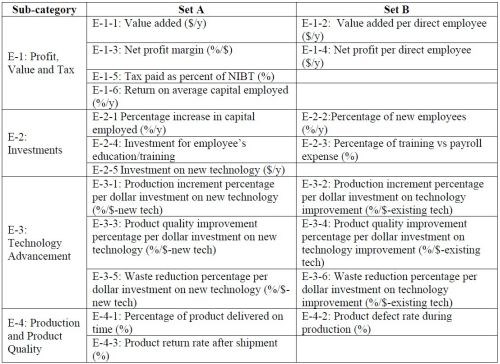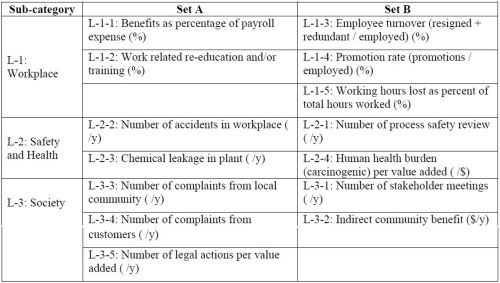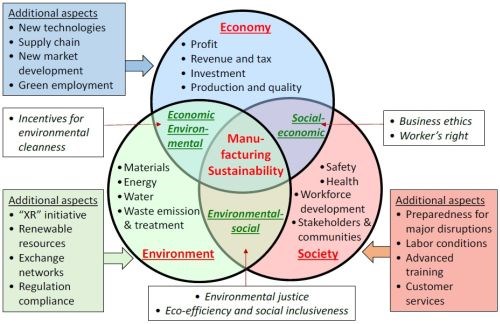NASF/AESF Foundation Research Project #121: Development of a Sustainability Metrics System and a Technical Solution Method for Sustainable Metal Finishing: 2nd Quarterly Report
This report covers the second quarter of project work (July-September 2020) on this project at Wayne State University in Detroit. The objective is to help metal finishing plants to conduct a self-managed sustainability assessment and identify technical solutions for sustainability performance improvement. The reader is invited to contact Dr. Huang in identifying plating shops willing to participate in this program.
by
Yinlun Huang*
Department of Chemical Engineering and Materials Science
Wayne State University
Detroit, Michigan, USA
Editor’s Note: This NASF-AESF Foundation research project report (1) introduces the project and (2) covers the second quarter of project work (July-September 2020) at Wayne State University in Detroit. A printable PDF version of this report is available by clicking HERE.
Overview
It is widely recognized in many industries that sustainability is a key driver of innovation. Numerous companies, especially large ones that made sustainability as a goal, are achieving clearly more competitive advantage. The metal finishing industry, however, is clearly behind others in response to the challenging needs for sustainable development.
This research project aims to:
- Create a metal-finishing-specific sustainability metrics system, which will contain sets of indicators for measuring economic, environmental and social sustainability,
- Develop a general and effective method for systematically sustainability assessment of any metal finishing facility that could have multiple production lines, and for estimating the capacities of technologies for sustainability performance improvement,
- Develop a sustainability-oriented strategy analysis method that can be used to analyze sustainability assessment results, identify and rank weaknesses in the economic, environmental, and social categories, and then evaluate technical options for performance improvement and profitability assurance in plants, and
- Introduce the sustainability metrics system and methods for sustainability assessment and strategy analysis to the industry.
This will help metal finishing facilities to conduct a self-managed sustainability assessment as well as identify technical solutions for sustainability performance improvement.
Progress report
Statement on student hiring
Due to the worldwide COVID-19 outbreak, the international student (from Iran) recruited for this project was unable to come to the U.S. for Ph.D. study in August 2020. .However, the PI has been successful in recruiting a new domestic Ph.D. student, Abdurrafay Siddiqui. This student has been working on the project since early September. He earned his B.S. degree in chemical engineering from Wayne State University in May 2020.
Scheduled project task for Quarter 2
According to the project schedule, the research task during the second quarter is to develop a sustainability metrics system. More specifically, it is to refine the initial sustainability metrics system reported in the last quarterly report in the following direction. That is, we review the initial sustainability metrics system, and divide 53 sustainability indicators (including one that has been newly added) into two sets:
- Set A – an indicator set that contains a minimum number of indicators definitely needed for conducting a meaningful assessment of sustainability in plants, although the scope will be limited, and
- Set B – an indicator set that contains the remaining indictors that can be used for more comprehensive sustainability assessment.
We planned to develop a list of parameters necessary for evaluating the values of the indicators in Set A. However, due to an urgent need to assess the impact of the COVID-19 pandemic on the metal finishing industry, the parameter development task was replaced by introducing new aspects to the sustainability metric system.
Identification of metal finishing companies that might be interested in reviewing the initial sustainability metrics systems and providing feedback also continues.
Project activities and progress
Identification of a minimum set of the initial sustainability metrics system
The PI and his student have conducted a more comprehensive literature survey on the sustainability metrics systems for different manufacturing sectors, and then proposed the division of the initial sustainability metrics system of 53 indicators into two sets that are presented in the following three tables. Note that for many indicators, their quantifications is based on per value added, rather than per dollar sales, which is more commonly used in the metal finishing industry. This is because the value-added basis counts not only the revenue from sales, but also the production cost, the unit depreciation cost and the labor cost.
Economic sustainability indicator sets
Out of 20 indicators, 12 indicators in four sub-categories are selected for Set A, and the remaining 8 are placed in Set B.
Table 1 - Economic stability

Environmental sustainability indicator sets
The 19 indicators in four categories are divided into two sets: Set A (12 indicators) and Set B (7 indicators).
Table 2 - Environmental sustainability

Social sustainability indicator sets
This set contains 14 indicators in three sub-categories that are divided equally into two subsets.
Table 3 - Social sustainability

In summary, the minimum set of sustainability indicators (i.e., Set A) contains 31 indicators, while the remaining indicators form Set B. We believe this could make sustainability assessment more efficient, while permitting more extensive assessment if those indicators in Set B are used.
Enhancement of sustainability metrics system for more robust assessment when facing severe disruptions
The COVID-19 pandemic has ushered in various unprecedented challenges and severely disrupted economic and social systems worldwide. In the U.S., one of the hardest-hit segments by the pandemic is the manufacturing industry, especially small businesses like the metal finishing industry. Health risks, demand reduction, supply chain disruption, etc. have slowed numerous manufacturing facilities to a standstill. It is impossible to predict precisely when the coronavirus will die down. According to Lloyd,1 automotive production, for example, will be unlikely to recover until after 2024. This has seriously affected many OEMs, suppliers and distributors, chemical and material manufactures, fuel producers, and many more.2 The metal finishing industry, like other manufacturing industries, needs to look beyond the fog of uncertainty towards long-term changes and develop strategies for more sustainable and resilient development in the future.
Sustainability metrics systems usually cover various aspects important to industries. Figure 1 presents an example where four major aspects within each of the three circles are listed. For these aspects, we have already generated 53 indicators that are divided into two sets. To make sustainability assessment more comprehensive, especially for industries that may experience major disruptions caused by global, national or subnational disasters, additional aspects and thus indicators should be explicitly included. Thus, our investigation has led to the introduction of 12 new aspects in three sustainability categories, which are briefly described below.

Figure 1 - Triple-bottom-line-based sustainability and addition of new aspects.
New economic aspects
Over the past decade, numerous technologies have been developed to advance manufacturing. The net benefits that could be offered to industries should be comprehensively evaluated in the sustainability domain. The robustness and resiliency of the supply chain, either global or local, and the effectiveness of developing new markets should be also assessed; these factors are critical for helping industries survive disruptions. According to Bowen, et al.,3 19.4% of U.S. workers could currently be considered part of the green economy in a broad sense. Green job transition should be considered as a new strategy, as it should potentially contribute significantly to economic growth. The four additional aspects to the economic sustainability category shown in Fig. 1 (see a rectangle box arrowed to the Economy circle) are new to the conventional metrics systems.
New environmental aspects
The 3Rs (reduce, reuse and recycle) Initiative was first introduced by Japan at the 2004 G8 Summit in Georgia. The U.S. and Japan reaffirmed the goals of the Initiative in 2007. In recent years, 3Rs have been expanded to 6Rs (i.e., adding recover, redesign and remanufacturing)4 and beyond (e.g., reclamation, repurposing and reintegration), depending on the type of manufacturing. It is highly recommended that companies launch “XR” (X > 3) initiatives, if they have not done so already. We need to investigate what the best for the metal finishing industry. The effectiveness of such initiatives should be evaluated annually.
Renewable resource utilization is becoming increasingly feasible. The establishment of exchange networks with other companies is another important pathway for participating companies to minimize waste materials and energy. In addition, the effectiveness of regulation compliance should be examined. These additional aspects to the environmental sustainability category are shown in Fig. 1.
New social aspects
The lessons learned from the COVID-19 pandemic undoubtedly help manufacturers to think deeply if the world faces a second wave of the virus or another major disastrous event in the future. Therefore, it is imperative for them to develop strategies and guidelines to prepare for possible major disruptions. Labor conditions, especially more comprehensive health risks to employees, customers and local communities, should be counted seriously. Advanced training of workforces, especially training for new technologies and guidelines, as well as improved communications and services to customers, should all be emphasized (see the additional aspects to the social sustainability category in Fig. 1).
New research needs
According to Huang,5 the inclusion of the 12 new aspects described above and thus an addition of a number of new sustainability indicators in different categories, should enhance sustainability assessment significantly for manufacturing sectors in the post–COVID-19 era. The new indicators will be carefully designed in order to provide a more accurate coverage of the new aspects and minimize redundancy with existing indicators. We understand that a sustainability metrics system containing too many indicators could be a challenge to users/decision makers in indicator selection and assessment. This demands the development of at least the following methodologies for (1) consolidating indicators in each category and subcategory, (2) constructing composite indicators for evaluating economic-environmental, environmental-social and social-economic performance, (3) aggregating indicators in groups and as a whole, especially when both hard and soft (qualitative) indicators are in the same group, and (4) predictive assessment under severe scenarios, especially with uncertain information. These will be our future research tasks.
Outreach effort
Since early September, the PI has been discussing with Christian Richter of NASF/AESF Headquarters about the possibility of launching an industry-wide sustainability initiative or forming a task force within NASF/AESF to discuss how to make the surface finishing sector more sustainable, smarter and resilient in the post COVID-19 manufacturing era. It becomes more likely that once metal finishing facilities are permitted to reopen, production will not be the same as pre-pandemic levels. It is highly important for the industry to discuss for some guidelines under severe uncertainty, so that metal finishers will be better informed in their decision making process. The PI will continue this effort to work with the Foundation in this direction. This should be greatly help the PI and his team to develop more effective sustainability metrics system, with successful industrial applications.
Plan for the 3rd Quarter (10/1/20 – 12/31/20)
There are three major technical tasks for the next quarter.
- Identification of all parameters needed for quantifying the indicators in both Set A and Set B.
- Development of new sustainability indicators based on the 12 newly added inspects, and then consolidate them into Sets A and B. Initiation of the development of a mathematical method using the enhanced sustainability metrics system (for both conventional and advanced sustainability assessments).
In addition, the PI will work with the AESF Foundation to discuss how to launch a sustainability initiative or form a task force.
References
1. A. Lloyd, “Impact of COVID-19 on the Manufacturing Industry,” https://www.interactanalysis.com/impact-of-covid-19-on-the-manufacturing-industry-infographic/ (accessed on October 15, 2020).
2. A.W. Bartik, et al., “The Impact of COVID-19 on Small Business Outcomes and Expectations,” PNAS. 117 (30), 17656–17666, 2020.
3. A. Bowen, K. Kuralbayeva and E.L. Tipoe, “Characterising Green Employment: The Impacts of ‘Greening’ on Workforce Composition,” Energy Economics, 72, 263–275, 2018.
4. I.S. Jawahir and R. Bradley, “Technological Elements of Circular Economy and the Principles of 6R-Based Closed-loop Material Flow in Sustainable Manufacturing,” Procedia CIRP, 40, 103-108, 2016.
5. Y. Huang, “Reinforcing Sustainability Assessment and Reshaping Technology Innovation for Highly Sustainable Manufacturing in the Post–COVID-19 Era,” in press, in special issue on Smart and Sustainable Manufacturing in the Post COVID-19 Manufacturing Era (S. Kumara, M.K. Tiwari, and Y. Huang, eds.), Smart and Sustainable Manufacturing Systems, 2020. http://doi.org/10.1520/SSMS20200062.
Past project reports
1. Quarter 1 (April-June 2020): Summary: NASF Report in Products Finishing; NASF Surface Technology White Papers, 84 (12), 14 (September 2020); Full paper: http://short.pfonline.com/NASF20Sep1
About the author

Dr. Yinlun Huang is a Professor at Wayne State University (Detroit, Michigan) in the Department of Chemical Engineering and Materials Science. He is Director of the Laboratory for Multiscale Complex Systems Science and Engineering, the Chemical Engineering and Materials Science Graduate Programs and the Sustainable Engineering Graduate Certificate Program, in the College of Engineering. He has ably mentored many students, both Graduate and Undergraduate, during his work at Wayne State.
He holds a Bachelor of Science degree (1982) from Zhejiang University (Hangzhou, Zhejiang Province, China), and M.S. (1988) and Ph.D. (1992) degrees from Kansas State University (Manhattan, Kansas). He then joined the University of Texas at Austin as a postdoctoral research fellow (1992). In 1993, he joined Wayne State University as Assistant Professor, eventually becoming Full Professor from 2002 to the present. He has authored or co-authored over 220 publications since 1988, a number of which have been the recipient of awards over the years.
His research interests include multiscale complex systems; sustainability science; integrated material, product and process design and manufacturing; computational multifunctional nano-material development and manufacturing; and multiscale information processing and computational methods.
He has served in many editorial capacities on various journals, as Co-Editor of the ASTM Journal of Smart and Sustainable Manufacturing Systems, Associate Editor of Frontiers in Chemical Engineering, Guest Editor or member of the Editorial Board, including the ACS Sustainable Chemistry and Engineering, Chinese Journal of Chemical Engineering, the Journal of Clean Technologies and Environmental Policy, the Journal of Nano Energy and Power Research. In particular, he was a member of the Editorial Board of the AESF-published Journal of Applied Surface Finishing during the years of its publication (2006-2008).
He has served the AESF and NASF in many capacities, including the AESF Board of Directors during the transition period from the AESF to the NASF. He served as Board of Directors liaison to the AESF Research Board and was a member of the AESF Research and Publications Boards, as well as the Pollution Prevention Committee. With the NASF, he served as a member of the Board of Trustees of the AESF Foundation. He has also been active in the American Chemical Society (ACS) and the American Institute of Chemical Engineers (AIChE).
He was the 2013 Recipient of the NASF William Blum Scientific Achievement Award and delivered the William Blum Memorial Lecture at SUR/FIN 2014 in Cleveland, Ohio. He was elected AIChE Fellow in 2014 and NASF Fellow in 2017. He was a Fulbright Scholar in 2008 and has been a Visiting Professor at many institutions, including the Technical University of Berlin and Tsinghua University in China. His many other awards include the AIChE Research Excellence in Sustainable Engineering Award (2010), AIChE Sustainable Engineering Education Award (2016), the Michigan Green Chemistry Governor’s Award (2009) and several awards for teaching and graduate mentoring from Wayne State University, and Wayne State University’s Charles H. Gershenson Distinguished Faculty Fellow Award.
* Dr. Yinlun Huang, Professor
Dept. of Chemical Engineering and Materials Science
Wayne State University
Detroit, MI 48202
Office: (313) 577-3771
E-mail: yhuang@wayne.edu
Related Content
3 Tests to Ensure Parts are Clean Prior to Plating
Making sure that all of the pre-processing fluids are removed prior to plating is not as simple as it seems. Rich Held of Haviland Products outlines three tests that can help verify that your parts are clean.
Read MoreAn Overview of Electroless Nickel Plating
By definition, electroless plating is metal deposition by a controlled chemical reaction.
Read MorePossibilities From Electroplating 3D Printed Plastic Parts
Adding layers of nickel or copper to 3D printed polymer can impart desired properties such as electrical conductivity, EMI shielding, abrasion resistance and improved strength — approaching and even exceeding 3D printed metal, according to RePliForm.
Read MoreLiquid Chrome Vs. Chromic Acid Flake
Contemplating how to continue offering chromic acid services in an increasingly stringent regulatory world? Liquid chrome products may be the solution you’re looking for.
Read MoreRead Next
Education Bringing Cleaning to Machining
Debuting new speakers and cleaning technology content during this half-day workshop co-located with IMTS 2024.
Read MoreEpisode 45: An Interview with Chandler Mancuso, MacDermid Envio Solutions
Chandler Mancuso, technical director with MacDermid Envio discusses updating your wastewater treatment system and implementing materials recycling solutions to increase efficiencies, control costs and reduce environmental impact.
Read MoreDelivering Increased Benefits to Greenhouse Films
Baystar's Borstar technology is helping customers deliver better, more reliable production methods to greenhouse agriculture.
Read More











.jpg;maxWidth=300;quality=90)








